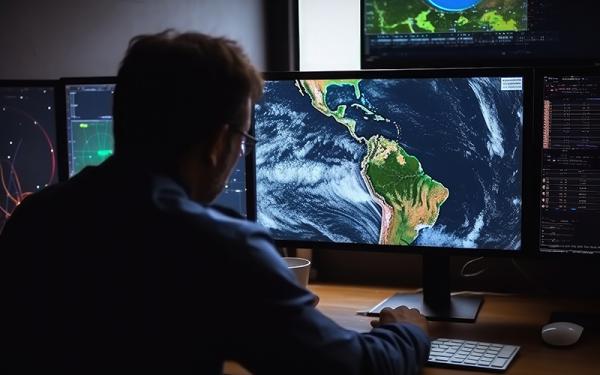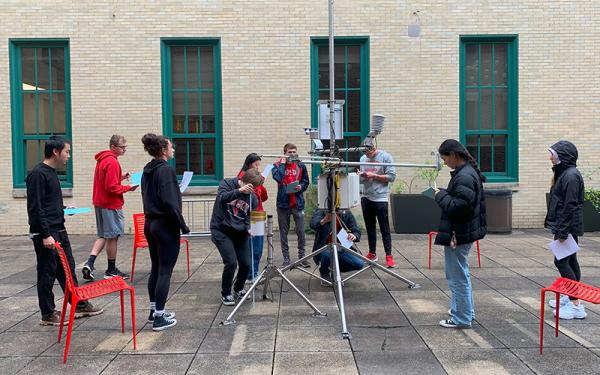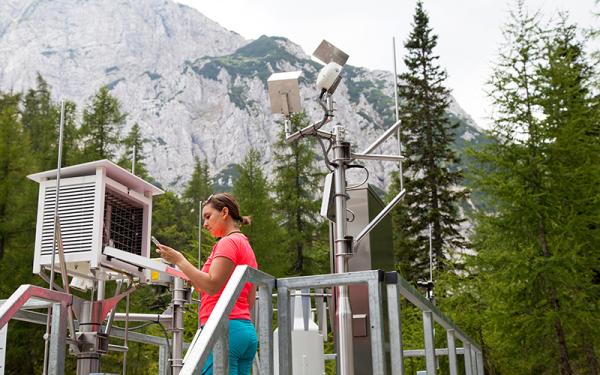The Atmospheric Sciences major integrates practices from across the sciences to help you understand the systems that determine our weather and climate.
You'll learn about the interactions between the Earth's surface and atmosphere that can often lead to severe storms, droughts and floods, and global climate change.
You'll be prepared to serve as an operational or broadcast meteorologist and research scientist.
The Atmospheric Sciences undergraduate curriculum fulfills the 1340 Series curricular requirements established by the American Meteorological Society. This coursework is required to apply for meteorology positions within the National Weather Service and other offices within the National Oceanic and Atmospheric Administration (NOAA).
There are no prerequisites you'll need to complete before declaring a major in Atmospheric Sciences. You'll begin with a solid foundation of courses in calculus, physics, chemistry, statistics, and meteorology. This coursework may seem daunting to some, but these courses will provide you the ability to synthesize complex interactions in your future career.
Below are a list of some of the issues and topics you'll study:
Weather Forecasting
- Satellite imagery
- Radar
- Programming
- Model output
- Reporting
- Seasonal forecasting
Severe Weather
- Thunderstorms
- Tornadoes
- Hurricanes
- Hail
- Hydrology
Micrometeorology
- Urban heat islands
- Pollution
- Energy budgets
- Surface effects
- Field research
- Instrumentation
Global Climate Change
- Human influence
- Glaciers/Ice sheets
- Impacts
- Detection
Climatology
- Droughts
- Floods
- Climates of the world
Below are a list of some of the skills you will develop:
Critical Skills
- Thinking and reasoning
- Oral and written communication
- Research design, interpretation, and implementation
- Ability to integrate and analyze information from a range of sources
Technical Skills
- Solid foundation in mathematics and the physical sciences
- Quantitative data analysis
- Synoptic and mesoscale weather forecasting
- Graphic communication (including map reading and geovisualization)
- Ability to develop graphical models and visually represent vast amounts of data
As an Atmospheric Sciences student, you are pursuing an education that integrates insights from across the sciences. You'll be prepared to enter directly into the workforce and apply for positions as both operational and broadcast meteorologists and research scientists in the private and public sectors.
According to the U.S. Bureau of Labor Statistics, median pay for atmospheric scientists (which includes meteorologists), is $84,000 per year and is growing at a rate of 4% per year for 2022-2032.
Possible career opportunities include:
- Operational Meteorologist at the National Weather Service or other NOAA offices
- Science Operations Office for the National Weather Service
- Certified Broadcast Meteorologist for local and national television stations
- Meteorologist for private firms in the aviation, agriculture, and utility industries
- Risk analyst for the insurance industry
- Professional storm chaser/Weather guide
- Meteorologist in the Military (Air Force and Navy)
- State Climatologist
- Service Hydrologist
- Researcher for the U.S. Geological Survey or the National Center for Atmospheric Research
- Environmental Analyst
- Business Consultant
Bureau of Labor Statistics, U.S. Department of Labor, Occupational Outlook Handbook, Atmospheric Scientists, Including Meteorologists,
at https://www.bls.gov/ooh/life-physical-and-social-science/atmospheric-scientists-including-meteorologists.htm
Curriculum for Atmospheric Sciences (BS)
If you are a student considering the Atmospheric Sciences degree, the downloadable file below will provide further information on the courses required.
Advising Sheet
Major curriculum information for students enrolling at OSU and declaring an Atmospheric Sciences major during Autumn 2022 or beyond, use this document.
General Education Requirements
Every student at Ohio State completes courses in General Education (GE). Although these GE courses are meant to provide a broad baseline of learning, often the courses supplement the student’s major or program. The requirements vary depending on whether you are pursuing a Bachelor of Arts degree, a Bachelor of Science degree. If you are not sure which curriculum you are following, ask your advisor. The College of Arts and Sciences has all the information you need to keep track of your General Education requirements.
Atmospheric Sciences Minor
If you are interested in learning about the Atmospheric Minor, please click here.
Curriculum for Atmospheric Sciences (BS)
If you are a student enrolled in the department during the Summer of 2022 or earlier, please use the following advising sheet:
Advising Sheet
General Education Requirements
Every student at Ohio State completes courses in General Education (GE). Although these GE courses are meant to provide a broad baseline of learning, often the courses supplement the student’s major or program. The requirements vary depending on whether you are pursuing a Bachelor of Arts degree, a Bachelor of Science degree. If you are not sure which curriculum you are following, ask your advisor. The College of Arts and Sciences has all the information you need to keep track of your General Education requirements.















